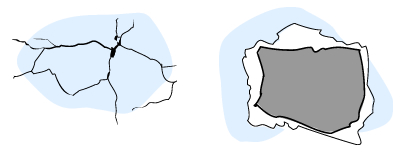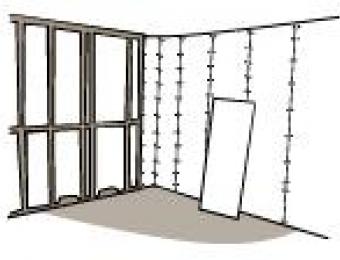
If you find yourself with a large hole in your plaster or plasterboard wall, don’t panic - they are quite easy to fix. Likewise, large cracks can be repaired without too much fuss - but if they're unexplained or persistent, get a builder to inspect your house to find out what the cause is. Large holes and cracks in walls need to be patched.
You need to assess whether your walls are plaster or plasterboard in order to select the most appropriate repair method. If your walls are plaster, check for damage on the wooden lath boards, and fix them first if necessary. There are a number of methods for patching large holes and cracks and plaster and plasterboard; three are listed below.
Newspaper method - for large cracks in plaster or plasterboard walls
First, scrape away any loose plaster from around the crack and make sure it's free from dust and debris. Spray the plaster with a bit of water and let it absorb. Fill the crack with newspaper. Mix a small amount of plaster of Paris and apply it to a filling blade. Spread the plaster over the newspaper in a layer roughly 1cm thick. Let the plaster dry for 10 minutes and then apply another layer. Repeat until the plaster is level with the wall, then let it dry overnight. Sand the plaster back using a fine grade sandpaper wrapped around a flat block, then apply a primer and repaint the area in the original colour.
Plasterboard patch - for large holes in plaster or plasterboard walls
Clean and tidy the plaster or plasterboard around the hole, then spray a little water on the plaster and allow it to absorb. For a plaster wall, trim a piece of plasterboard to fit the hole. You may need to dig at the existing plaster to ensure your patch will sit flat. Apply a 1cm thick layer of plaster of Paris to the lath boards or the existing plaster, and allow to dry for at least 10 minutes. Repeat, building plaster layers until your patch sits level with the wall.
For a plasterboard wall, find a square or rectangular piece of plasterboard that just covers the hole, put it over the hole, and trace around it onto the wall. Using a keyhole saw, cut the wall along the traced lines, checking first for cords and wires. Clean the edges off and gently moisten the plaster around the edges. Make backing strips 150mm wide for your patch out of plasterboard or small bits of timber and attach these to the inside of the wall with some glue. Wait for the glue to dry, then apply more glue to the backing strips and fit the patch into place. Once your plaster or plasterboard wall has its patch in place, tape the patch to the wall using plaster tape, without overlapping the tape. Apply filler around the edges of the patch, allow to dry, then sand and paint using directions outlined above.
Cardboard and string patch - for large holes in plasterboard walls
Take a piece of cardboard or plasterboard slightly larger than the hole, but still small enough to fit through the hole. Put a hole in the centre of the patch, and thread a piece of string through it. Tie a nail (or paperclip) to one end of the string - this side is the back of your patch. Clean debris and moisten the plaster around the edges of the hole as per the previous instructions, then coat the front of the patch with filler.
Holding the string, push the cardboard or plasterboard through the hole, nail side first. Use the string to pull the patch towards you and position it so it covers the hole. Pull the string tight, and apply another layer of filler to fill the hole. Tie the string around a pencil or piece of wood and wind until it sits tightly against the wall. Once the filler has set, cut the string flush with the surface. Sand back and repaint following the previous instructions.


